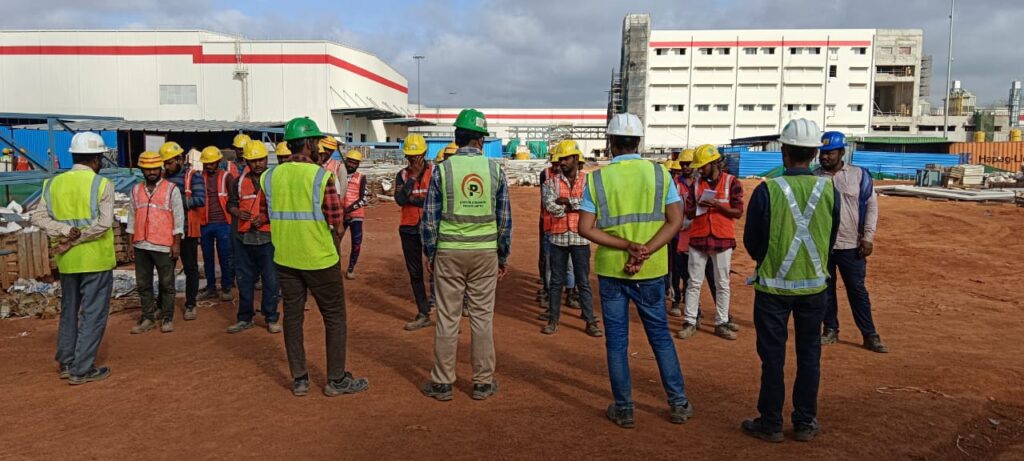Introduction
The Exide Project
Exide Energy is building a lithium battery cell plant at Devanahalli Industrial Area near Bengaluru. This greenfield project, spanning 40 acres with a production capacity of 6000 GW, is a major milestone for Exide. Safety in construction was a top priority, and Pramila Projects being one of the major erectors among other companies which in total achieved zero incidents over 3 lakh man-hours, demonstrating our commitment to a safe work environment.
Exide Project: Comprehensive Overview
Client and Project Introduction
Introducing Exide: Core Business Models and Industry Impact
Exide Industries, a leader in battery manufacturing, is expanding into lithium battery production to meet the rising demand for energy storage solutions. This move supports global trends towards renewable energy and electric mobility.

The Main Cell Exide Plant: Advancing Client Goals
The Main Cell Exide Plant will boost Exide’s production capabilities, helping them capture a significant share of the lithium battery market and supporting the transition to sustainable energy.
Detailed Breakdown of Sheeting and Erection Work
Sheeting Process
Pramila Projects handled sheeting the roof area of 71,550 sqm and cladding area of 31,180 sqm. The deck sheet area covered 24,428 sqm. This required careful planning and execution to ensure structural integrity and weather protection.
Erection Tasks
The erection process involved assembling and positioning steel structures weighing a total of 8,400 MT. The project was divided into four zones, each with specific challenges and timelines. The team maintained strict safety protocols to ensure precision and stability.

Timeline of Excellence
Project Timeline and Key Milestones
| Sl. No. | Description | Primary Erection | Roof sheeting Work | Cladding Work | |||
| Plan Days | Achieved Days | Plan Days | Achieved Days | Plan Days | Achieved Days | ||
| 1 | Zone-04 | 99 | 114 | 50 | 63 | 59 | 77 |
| 2 | Zone-03 | 81 | 103 | 40 | 50 | 42 | 40 |
| 3 | Zone-02 | 81 | 77 | 40 | 49 | 42 | 37 |
| 4 | Zone-01 | 111 | 56 | 55 | 28 | 57 | 47 |
The project was executed in phases, with key milestones in each zone:
A highlight of Zone 1 was erecting structures on an RCC slab with a load capacity of 20 MT per segment. We safely lifted the mainframe structure using a 500 MT crane from the perimeter of the zone area, completing the primary structure within 28 days by working from the outside.

Safety Challenges: Tackling Big Risks in Major Projects
Identifying Safety Risks

Inherent Safety Risks in Large-Scale Construction
Large projects like the Exide plant come with inherent risks, including accidents during equipment movement, structure erection, and working at heights. Identifying these risks early helps in planning effective safety measures.
Major Risks Highlighted in the Safety Assessment
The safety assessment identified risks such as equipment movement, load handling, structure lifting, and working at the roof edge. Each risk required tailored mitigation strategies to prevent incidents.
Detailed Risk Assessment
Discussion of Safety Risks Identified
The risk assessment evaluated job site conditions, identified hazards, and assessed their potential impact. This helped develop effective strategies to mitigate risks and ensure worker safety.
Our Safety Commitment in Action: 3 Lakh Man-Hours, Zero Incidents
Proactive Safety Measures
Actions Taken to Mitigate Identified Risks

Job Safety Analysis (JSA) and Hazard Identification and Risk Assessment (HIRA) were crucial in identifying and addressing safety risks. Measures included deploying flagmen, checking crane load charts, and using guide ropes for structure lifting.
Effective Risk Management Plans
Implementation of Risk Management Strategies
The risk management plan included forming a safety committee, conducting weekly equipment inspections, maintaining a Permit to Work (PTW) system, and providing skill development training and motivational programs.
Harnessing Technology for Safety
Using Technology to Enhance Safety Measures

Digital induction systems were implemented for better project understanding and safety compliance. Technology played a vital role in saving lives and time, ensuring that workers were well-informed and equipped to handle tasks safely.
Specific Safety Protocols and Innovations
Morning Tool Box Talks (TBT) were mandatory for all staff and workers to discuss safety experiences and learnings. A penalty system for safety violations reinforced compliance.
Learnings from the Project
Key Takeaways
Lessons Learned from Maintaining a Zero-Incident Record
Maintaining a zero-incident record reinforced the importance of commitment to safety. It boosted the confidence of the team, gained client trust, and showed that the organisation values worker safety.
The Importance of a Safety-First Culture in Future Projects
A safety-first culture ensures skilled workers are properly engaged, tools and equipment are safely used, and the work environment remains stress-free. Proper housekeeping and safe disposal of waste and fuel further contribute to safety.
Enhancing Future Projects

Recommendations for Improving Safety Measures
Future projects can benefit from digital induction systems, Best Behavior Safety (BBS) training, and increased awareness of safe working culture. A centralised record system for safe man-hours, near-miss reports, and Lost Time Accidents (LTA) can help track and improve safety performance.
Insights on Improving Project Management and Execution Strategies
Key insights include the importance of skilled resources, daily site meetings for planning, reliable equipment, and experienced project leadership. Strengthening material management systems can also improve client material accountability.
Celebrating Achievements

Project’s Success in Maintaining Safety and Achieving Zero Incidents
The project’s success in maintaining safety and achieving zero incidents over 3 lakh man-hours is a testament to Pramila Projects’ commitment to excellence. The team’s dedication ensured a hassle-free work environment, improved morale, and significant time and cost savings due to the absence of injuries.
Acknowledgment of the Team’s Dedication and Efforts
Pramila Projects extends heartfelt appreciation to the entire team for their dedication and effort in achieving this remarkable safety milestone.
Commitment to Continuous Improvement

Reaffirming Pramila Projects’ Dedication to Safety
Pramila Projects remains committed to prioritising safety in all future projects. The lessons learned from this project will serve as a foundation for continuously enhancing safety standards.
Vision for Ongoing Enhancement of Safety Standards and Practices
The vision for the future includes ongoing improvements in safety protocols, technology integration, and fostering a safety-first culture. Pramila Projects aims to set new benchmarks in construction safety, ensuring a safe and productive work environment for all.
